Trieste
![]()
This article is about the city of Trieste in Italy, for other meanings see Trieste (disambiguation).
Trieste [[triˈɛst]] or [trˈiɛst]] (Triestine/Venetian as well as Italian Trieste, Furlanian Trieste, Slovenian and Croatian Trst, Latin Tergeste) is a port and major city located in northern Italy on the Gulf of Trieste with 203,234 inhabitants (as of December 31, 2019), including a Slovenian minority. Located on the upper Adriatic Sea directly on the border with Slovenia, Trieste is the capital of the autonomous region of Friuli-Venezia Giulia and was the capital of the province of Trieste until 2017, when it was dissolved.
Trieste is the seat of the Roman Catholic Diocese of Trieste. The city, which has been a university town since 1924, is home to two well-known observatories for astronomy and geophysics, respectively. It is the headquarters of global companies such as the coffee producer illycaffè S.p.A., the insurance company Generali, the shipbuilding company Fincantieri, and the shipping company Italia Marittima (formerly Lloyd Triestino or Austrian Lloyd).
As early as 774, Trieste became part of the Frankish Empire under the future Emperor Charlemagne. In the continuity of the empire, the eastern part of the Frankish Empire developed into the Holy Roman Empire of the German Nation, of which Trieste remained a part for almost 1000 years, with short interruptions (see History paragraph), until its fall in 1806. Even after that, the city belonged to the German Confederation as part of the Austrian Empire from 1815 to 1866. From 1382 to 1918 Trieste was part of the Habsburg Monarchy and the Austro-Hungarian Empire. It was its most important trading port, one of the bases of the imperial and royal navy and the seat of the governor. It was also the seat of the governor of the Austrian Littoral and of the three crown lands formed from it in 1861: the Principality of Gorizia and Gradisca, the Margraviate of Istria and the Imperial City of Trieste.
Culturally and historically, Trieste, even as part of Italy since 1918, remained a place of encounter of cultures, languages, ethnicities and religions ("Città mitteleuropea"). After 1945, the city and its mixed-language hinterland were successfully claimed by Yugoslavia; after an interlude as the Free Territory of Trieste, the city was once again subject to the Italian state from 1954.
For decades, the East-West conflict placed Trieste, like Berlin, on the fault line between East and West, in a marginal position in terms of transport policy. The disadvantage of this border location and the resulting loss of economic importance fell away with Slovenia's accession to the EU in 2004 and its entry into the Schengen area, which led to the elimination of border controls with Italy on December 21, 2007, and Croatia's accession to the EU in 2013.
Trieste, with its deep-water port, is today, as it was before 1918, a maritime gateway for northern Italy, Germany, Austria and central Europe, and is considered the terminus of the Maritime Silk Road (21st Century Maritime Silk Road) with its connections via the Suez Canal or Turkey and overland to China, Japan and many Asian countries.
The port of Trieste has an international duty-free area (free port) with five free zones. Since the 1960s, Trieste has been one of the most important research locations in Europe due to its many international organizations and institutions, an international school and university city, and has one of the highest standards of living among Italy's cities. The city was rated as one of the top 25 small cities in the world for quality of life in 2020 and one of the top ten safest cities in the world in 2021. The city has the highest proportion of researchers and scientists to population in Europe.
Trieste has a very long coastline, free sea access in Barcola and is surrounded by grassland, wooded and karstic areas. In the city, on the Molo Sartorio, there was the Mareograf, to whose fixed values, from 1875 and 1900, most of the reference altitudes in Central Europe refer, with the marking "meters above Adriatic". Trieste is also the Città della Barcolana, as the signs at the entrances to the city make clear, and thus the annual venue of this world's largest sailing regatta.
Trieste is located at a crossroads of Latin, Slavic, Greek and Jewish cultures, where Central Europe meets the Mediterranean region. It is therefore considered one of the literary capitals and has often been called an early New York because of its diverse ethnic and religious communities. There are also other national and international names for the city, such as Trieste città della bora, Città del vento, Trieste città mitteleuropea, Trieste città della scienza - City of Science, City of the Three Winds, Vienna by the Sea or City of Coffee, in which individual defining characteristics are highlighted.
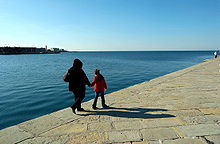
Port Quay Molo Audace

View from the lighthouse to the Barcola district with the city beach
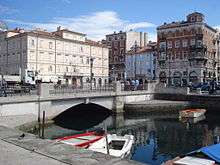
Ponterosso Square in the city center
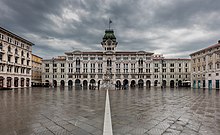
The Town Hall in Piazza dell'Unità d'Italia
Geography
Location
Trieste is located in the northeast of Italy on the Gulf of Trieste, a sea bay of the Upper Adriatic, a few kilometers from the Slovenian border. The city is part of the historical region of Julian Veneto (Venezia Giulia), also known as the Austrian Coastal Region before World War I, whose territory is now divided between the states of Italy, Slovenia and Croatia. Since Trieste lost a large part of its hinterland due to the border demarcations of the 20th century, Venezia Giulia was united with Friuli to form the autonomous region of Friuli Venezia Giulia, whose capital has been Trieste since 1962.
Trieste and its hinterland extends from the slope of a high coastal stage of the karst of the same name (Triestine Karst), which passes to the inland into a stony, shaded, calcareous and waterless high landscape, to a coastal lowland zone on the Adriatic Sea. The high landscape areas are known for their caves, sinkholes and other karst forms. The urban area of Trieste extends southward into a flysch area, which in the form of a double depression extends beyond the urban area and the national border to Pazin.
Characteristic of this area is also the soil type Terra rossa, a red clay derived from limestone weathering, which is particularly suitable for growing wine. In the Carso wine-growing area, which surrounds the city of Trieste, the Carso Terrano vine, a variety of the Refosco grape, is cultivated above all. The area was awarded the DOC quality label in 1985. In 1986, the Province of Trieste opened the Terrano Wine Road ("Strada del vino Terrano") between the towns of Opicina and Sistiana.
As the most important port of Austria or Austria-Hungary (1382-1918), Trieste became a center of nautical science and oceanography. The harbor basin was given a long-term observed tide gauge at Molo Sartorio, to which the Central European altitude system meters above the Adriatic has been referred since the 19th century; it was looked after by the meteorological observatory founded in 1841, which today belongs to the Geophysical Institute of Trieste.
Climate
The climate of Trieste is sub-Mediterranean. It is characterized by hot, dry summers and mild, rainy winters. In summer the average temperature is 25 °C, in winter 8 °C.
Summer water temperatures range from 24 °C to 28 °C near the coast. The annual precipitation is about 1023 mm, the relative humidity 64 %. In Trieste there are about 200 days a year when there is no wind. Thus, compared to other seaside cities, it is not particularly windy in the city.
Characteristic for the climate of Trieste are the three winds: bora, scirocco and mistral. The winds are the cause of the favorable climate of the city, as it is rarely cold and wet at the same time.
The bora, which often occurs in winter but also in the rest of the year, is a cold, dry downdraft wind from the northeast that starts suddenly, can also last for weeks, and blows in strong gusts from the land to the open sea. It is channeled in the bay of Trieste and thus reaches high wind speeds in the city, in isolated cases far above 100 km/h. While the high wind speeds in the urban area of Trieste can lead to chaos, especially in winter in combination with ice and snow, the bora has positive effects on the well-being of the people. It is said that "the bora blows away the bad moods". Many sick people feel relieved of their ailments, weather sensitivity and pain on bora days.
The rarer scirocco, unlike the bora, is a warm, humid east-southeast wind accompanied by heavy clouds and rain. In summer, the most common is the mistral, a light breeze that blows from the sea towards the land and cools warm summer nights.
As a result of the climate and despite its northern location, on the one hand Trieste can still produce excellent olive oil (it is said that the city is located on the olive oil-butter border) and on the other hand the city administration or rather the house owners regularly struggle with termite infestation of the historic properties.
| Trieste | ||||||||||||||||||||||||||||||||||||||||||||||||
| Climate diagram | ||||||||||||||||||||||||||||||||||||||||||||||||
| ||||||||||||||||||||||||||||||||||||||||||||||||
| Monthly average temperatures and precipitation for Trieste
Source: wetterkontor.de | ||||||||||||||||||||||||||||||||||||||||||||||||||||||||||||||||||||||||||||||||||||||||||||||||||||||||||||||||||||||||||||||||||||||||||||||||||||||||||||||||||||||||||||||||||||||||||||||||||||||||||||||||||||||||||||||||||||||||||||||||||||||||||||||||||||||||||||||||||||||||||
History
Foundation
At the time of the foundation of Aquileia by the Romans, the area around Trieste was inhabited by Celtic and Illyrian tribes. When the Romans undertook campaigns from Aquileia to Istria from 177 BC, they received support from inhabitants of a village called Tergeste, the first place in Illyria, in the territory of the Histrians. This period also saw the foundation of three Roman military camps, the main 13-hectare San Rocco fort between the two smaller forts at Monte Grociana Piccola to the northeast and Montedoro to the southwest. In 128 B.C. the first settlement of Roman citizens took place in Tergeste. The settlement of Tergeste was mentioned by the Greek geographer Artemidor of Ephesus in 104 B.C. and at that time it was already a Roman settlement on what is now the town hill of San Giusto, where the origins of the settlement are located.
In the second half of the 1st century BC, in the Triestine suburb of Barcola, an elaborate princely Roman villa was built. This private villa was located between today's cemetery and the church of San Bartolomeo, approximately at Viale Miramare 48, directly on the sea with a unique panoramic view. The "Villa Maritima" extended along the coast and was divided in terraces into a feudal representation area, ceremonial hall, separate living area, garden, some facilities open to the sea and a spa. Extensions and alterations can be traced back to the second half of the 1st century AD. The artworks, statues and mosaics found are now in the Museum Lapidario Tergestino in the fort of San Giusto, although comparable works have so far only been found in Rome and Campania.
Already from the first century A.D. Barcola (as "Vallicula" or later "Valcula"), with its climatic advantages and a series of villas for patricians and nobles, developed into an exclusive Roman tourist resort. At that time, as already mentioned by Pliny the Elder, the vines of the Pulcino wine (a presumed predecessor of Prosecco) were grown on the slopes. It was the favorite wine of the Empress Livia, wife of Augustus, grown only there, and is said to have been praised already by the Greeks under the name of Pretetianum.
Around the birth of Christ, Trieste functioned as a frontier fortress against the Japys settled in the Eastern Alps. The name Tergeste, which probably means "market" and which became Trieste, was retained by the Romans when, in the mid-1st century A.D., Tergeste developed as a Roman colony into an important port in the Roman Empire, with trade routes along the Adriatic and across the Julian Alps. However, at that time Trieste never attained the importance of Aquileia, which was opposite the Gulf of Trieste. Roman Tergeste had access to the sea through a port and was protected by new walls from 33 BC. In 27 BC Tergeste was assigned to the X Italian region "Venetia et Histria". At the time of Trajan (98-117 AD), the city had 12,000 inhabitants and received a basilica and a theater. Towards the end of the 3rd century A.D. the rich Roman dwellings and villas were abandoned and a period of regression and retreat to the hill area began, which was fortified again. The buildings acquired a rural character and instead of masonry, wood was often used.
After the fall of the Western Roman Empire in 476, Trieste shared the general fate of Istria, where Ostrogoths, Byzantines and Lombards followed each other in rule, until the city was incorporated into Charlemagne's Empire in 774 as a part of the Marche of Friuli. Under Emperor Lothar III, the Bishop of Trieste received secular sovereignty over the city.
Trieste retained independence under its bishops until the conquest by Venice in 1203. For the next 180 years, Trieste's history consisted mainly of a series of conflicts with powerful Venice in tension with the claim of the Patriarch of Aquilea. Venice also forced the demolition of the city walls, which were, however, rebuilt during the 14th century. Since Trieste did not have its own army, it was the duty of the citizens, which they could not avoid, to keep watch on the walls themselves and to perform military service. In order to preserve Trieste's independence, in 1382 the citizens of Trieste placed themselves under the protection of Leopold III of Austria, who was also the sovereign of the neighboring Duchy of Carniola. The autonomy of the city had to remain untouched and the Austrian prerogatives referred only to the appointment of a military governor.
Austrian rule
→ Main article: Imperial Immediate City of Trieste and its Territory
Trieste was Habsburg-Austrian from 1382 to 1918. On September 30, 1382, Duke Leopold III accepted the voluntary submission of the city of Trieste in the castle of Graz. In the 15th century the city was repeatedly the scene of bitter conflicts between the imperial party, the supporters of the Lords of Duino and the Venetians. Especially in the years 1467 to 1469, civil strife led to acts of terror and devastation in the streets of Trieste. The protectorate, however, slowly developed into a real possession, the Austrian Coastal Land (Litorale). For a long time the Habsburg rule in Trieste was nominally represented by the dynasty of the Counts of Montenari. The governorship was initially conferred ad personam by the respective monarch (who was usually also Holy Roman Emperor, but did not rule there in this capacity, but as ruler of the Habsburg hereditary lands), and later passed on hereditarily to the eldest son of the Count of Montenari according to the law of primogeniture.
Apart from repeated brief occupations (especially in 1508/09) by Venice and the Napoleonic period (1797, 1805-1806 and 1809-1813), Trieste remained part of Habsburg Austria until the end of the First World War.
Trieste's rise in the 18th century
Trieste's rise in the Danube Monarchy began in 1719 with Charles VI's elevation of the city to a free port - a status it retained until 1891. Charles' successors Maria Theresa and Joseph II supported Trieste's economic boom by creating important urban quarters, the "Maria Theresa City" (Borgo Teresiano) northeast of today's main square and the "Joseph City" (Borgo Giuseppino) southwest.
As Austria's only major seaport, Trieste occupied an important strategic position in the Habsburg monarchy and was the starting point of short-lived colonial acquisitions (Triestiner Handelskompanie). However, for a long time Venetian pressure hampered Trieste's economic development. Only the conquest of Venice by Napoleon at the end of the 18th century and the subsequent Peace of Campo Formio, in which Venice was awarded to Austria, ushered in the decline of the Republic of Venice and the heyday of Trieste.
With Austrian support, Trieste replaced Venice in its leading role in trade with the Middle East and became the largest commercial center in the Adriatic. In 1802, the port of Trieste handled 483,326 tons of goods transported by 5,442 ships. At the peak of Trieste's prosperity, about 100 years later, there were more than twice as many ships and more than ten times as many goods, mainly coffee, sugar and tropical fruits, as well as wines, oils, cotton, iron, wood and machinery.
Wilhelminian period in the 19th century
In 1804 Trieste became part of the newly founded Empire of Austria, further as part of the Littoral. Under Napoleon, Trieste was added to the Illyrian Provinces in 1809 and thus became French until 1814. This short period left its mark in neoclassical buildings such as the Trieste Opera Teatro Verdi, built according to the plans of the architect Matthaeus Pertsch.
In 1813 Austria reconquered Trieste under General Christoph Freiherr von Lattermann. After the Congress of Vienna in 1815, Trieste was incorporated into the newly created Kingdom of Illyria within the Austrian imperial state.
After having been part of the Holy Roman Empire of the German Nation for centuries under Habsburg rule, Trieste, as an Austrian city, also belonged to the German Confederation, created in 1815 at the Congress of Vienna as a replacement for the old Empire, which had perished in 1806. The city roughly marked the southern extension of the German Confederation to the Adriatic Sea. In this respect, as a consequence of the bourgeois revolution of 1848, Trieste was naturally part of the electoral area for the German or Frankfurt National Assembly (also constituent Reich Assembly, Reich Parliament, German National Parliament or already Reichstag). In these first all-German, free and democratic elections, three deputies - Karl Ludwig von Bruck, Gabriel Jenny and Friedrich Moritz Burger - were elected to the parliament of the constituent German Reich in Frankfurt in the constituencies of Küstenland-Triest-Stadt 1 and 2. Even after the failure of the Revolution and the Empire, Trieste remained part of the restored German Confederation until its end in 1866. With the Peace of Prague, concluded in that year to end the German War, Austria, and with it Trieste, left the German Confederation after centuries of belonging to it.
On July 1, 1829, Josef Ressel made the first successful test voyage with a propeller on the ship Civetta, built in Trieste. During this period, insurance companies, shipyards, bank branches and shipping companies began to be founded in Trieste, including Assicurazioni Generali (1831), Österreichischer Lloyd (1833), the San Marco shipyard (1839/1840), Giuseppe Tonello's shipyard (1852) and, in 1860, the Lloyd Arsenal, as the private shipyards could no longer keep up with the production of the rapidly growing shipping companies.
In 1850 Trieste became the seat of the Imperial and Royal Central Maritime Authority. Since 1857, the Austrian Southern Railway has connected Trieste with Vienna via Semmering. The first mountain railroad in Europe was built according to the plans and under the direction of the Venetian Carl Ritter von Ghega.
In 1857/58, the Strudenhoff machine factory in Sant'Andrea and the San Rocco shipyard gave rise to the Stabilimento Tecnico Triestino (S.T.T.) in Muggia, opposite the city in the bay. This new large company also bought Giuseppe Tonello's shipyard in 1897, which by then had been expanded into a large shipyard. S.T.T. was able to build ships with a displacement of up to 20,500 tons - such as the large battleships of the Imperial and Royal Navy. Kriegsmarine - were built.
From 1867 onwards, the old port facilities, which no longer corresponded to the growing trade, were expanded. First, the free port (punto franco) located to the north was expanded. During the monarchy, the port city drew, among other things, the main benefit from the Suez Canal, opened in 1869. Austrian industrial products were now also sold in Turkey, Egypt and Syria.
Trieste and nationalism
In the revolutions of 1848, uprisings took place in the Austrian provinces of Lombardy and Veneto against Habsburg rule and for a united Italian nation-state (see also Risorgimento). Trieste remained loyal to Austria and was given the title Città Fedelissima - the "most loyal city of all".
In 1849 the Austrian administrative unit Kingdom of Illyria was broken up into its component parts. Trieste and the immediately adjacent territory were constituted as the Imperial Immediate City of Trieste and its territory with its own constitution and Diet and in the status of a crown land; likewise Gorizia and Gradisca and Istria. (Carinthia and Carniola, until then also parts of Illyria, also became crown lands in their own right).
In 1852-1861, the three political entities were merged to form the crown land of the Austrian Coastal Province. The Imperial Constitution of 1861 again divided the three parts into independent crown lands, which existed until 1918. The only thing they had in common was the k.k. Statthalter in Trieste as representative of the emperor and the Viennese government and a common publication organ of their legislation. The 1867 transformation of the unified state of the Austrian Empire into the Austro-Hungarian Monarchy did not change anything for Trieste's self-government; it was now counted as part of Cisleithania and was represented in the House of Representatives of the Imperial Council in Vienna, the Cisleithanian parliament, with five deputies at last.
However, a growing Italian irredentist movement also began in Trieste, which was largely inhabited by Italians, with the aim of detaching Trieste from Austria-Hungary as an Italian-speaking territory and joining the nation-state of Italy, founded in 1861. Irredentism peaked when Emperor Franz Joseph I visited Trieste in 1882 to mark 500 years of Habsburg rule over the city. During anti-Austrian demonstrations, the emperor narrowly escaped bombing by Guglielmo Oberdan (Wilhelm Oberdank) and his accomplices. Trieste remained one of Austria-Hungary's hottest spots of conflict in the nationality struggle until 1914, as Austria relied on this port city, which was extremely important for trade and the Imperial and Royal Navy. Austria could not and did not want to do without this port city, which was extremely important for trade and the Austro-Hungarian navy. (Hungary had developed the port city of Fiume, Croatian: Rijeka, for itself).
All in all, the Trieste elite looked toward Vienna, while a few young Italian irredentists sacrificed themselves for Italy. However, the inhabitants of Trieste and many intellectuals knew exactly what was important in their city, because economically Italy and Trieste were hardly dependent on each other, but Austria and Trieste were all the more so. Only a minority demanded unification with the Kingdom of Savoy or Italy, but Slavic nationalism was perceived as a challenge by many Italian-speaking Triestians.
Further upswing before the First World War
In 1880, the volume of cargo handled in the ports of Trieste was 1.225 million tons. By 1912, this volume had increased to 4.573 million tons. In 1883, the 30 million crowns port reconstruction in the south of the city was completed. The storage areas as well as the new southern railway station (stazione meridonale), which today is the only passenger station in the city still in existence, were largely built on filled land.
Despite the political and national problems, Trieste continued to flourish economically and culturally. In addition to the Trieste-Vienna Southern Railway, with a connection to the Moravian-Silesian industrial area, from 1909 the Tauern Railway provided a direct connection to western Austria and southern Germany via Gorizia and Villach to Salzburg. The most important railroad station until 1918 was the state station (stazione dello stato) of the k.k. Staatsbahnen. Between it and the Lloydareal stretched the new port (porto nuovo), which was expanded from 1898 and was called Josephs-Hafen until the end of the monarchy.
Around 1900, the city was in its full economic bloom and flaunted its wealth with numerous magnificent buildings. In Trieste worked some of the architects who were responsible in Vienna for magnificent Ringstrasse buildings in the style of historicism, such as Heinrich von Ferstel (e.g. Lloydpalast), Wilhelm von Flattich (e.g. Südbahnhof), Friedrich Schachner (various palaces). Writers and artists such as James Joyce and Italo Svevo frequented the city. It was in the port city of Trieste that the Irishman Joyce came into contact with the multi-ethnic Austro-Hungarian state. On the one hand, he incorporated his impressions of Trieste into his works, and on the other, he judged the state system of the time with "They called the Austrian Empire a ramshackle empire, I wish to God there were more such empires".
Trieste was one of the most economically developed areas of the Habsburg Empire. In 1906, the taxable per capita income of a Triestinian was 54 crowns, while that of a Viennese was about 9 crowns.
The city center of Trieste, with its cosmopolitan population mix of Italians (75%), Slavs (18%), Germans (5%) and inhabitants of other peoples, advanced, as Claudio Magris noted decades later, to become the literary capital of Central Europe. The adjacent districts had mostly Slovenes (52%), Italians (43%) and Germans (4%) as inhabitants, and the rural surroundings were almost entirely Slovenian (93%). Almost every Triestinian was multilingual, with Italian being the leading language of communication.
In the years leading up to the First World War, mainly at the insistence of Archduke Franz Ferdinand, heir to the throne, a series of shipbuilding projects were carried out in Trieste for the Imperial and Royal Navy. Kriegsmarine was carried out. The heir to the throne usually took part in the launches, e.g. SMS Viribus Unitis in 1911 and SMS Tegetthoff in 1912.
See also: Austrian Merchant Navy
World War I
With the outbreak of the First World War in August 1914, the economic and artistic-literary development in Trieste came to an abrupt halt. Many thousands of Triestians moved to the interior of Austria-Hungary even before Italy declared war on Austria-Hungary on May 23, 1915. From Trieste initially about 32,500 men between 18 and 37 years of age went to the front and in the course of the war about 50,000 Triestines aged up to 50 years were drafted. The house regiment of the Triestines, the k.u.k. Infantry Regiment No. 97, was transported by rail towards Lviv in Galicia on August 11, 1914, where it was involved in the heaviest defensive battles against the advancing Russian army.
On May 23, 1915, Italy, which had been neutral until then, declared war on Austria-Hungary as a new member of the Triple Entente. This created a front a few kilometers northwest of the city; many foreigners such as James Joyce had to leave Trieste. The Italian declaration of war triggered massive protest rallies against Italians; in particular, crowds stormed the editorial office of the newspaper "Il Piccolo", the headquarters of the "Lega nazionale" was destroyed, and stores and coffee houses owned by Italians were looted. With Italy's entry into the war, Trieste was militarized. Because of the nearby front, air defense positions were built on roofs and squares; schools and buildings were converted into hospitals. Young "marinaretti" and "scauti" helped older soldiers to supervise public order. The city depopulated and some 35,000 "regnicoli" - Italian workers living in Trieste - returned with their families to their Italian homeland. However, many regnicoli did not leave the city and about 15,000 of them were interned by the authorities in various camps along with over a thousand people who appeared suspicious. About 900 Triestines with Italian sentiments deserted from the Habsburg army, illegally crossing the border and joining the Italian forces. Often viewed with suspicion by their Italian comrades and commanders, half of these irredentists nevertheless attained the rank of Italian officer. The pro-Italian attitude of some Triesteans and the frontline location of Trieste led to sharp surveillance of the city by the imperial and royal military authorities. Military authorities. The 10th battalion of the k.u.k. Infantry Regiment No. 97 remained in Trieste; it participated in the defense of the Karst line in the Isonzo battles and was almost completely wiped out in 1915/16.
The writer Diego de Castro, who came from old irredentist Istrian nobility and was born in 1907, later assessed the Triestines during the war as largely Habsburg or austrophilic and said that the small, indomitable group of irredentists around Mario Alberti was limited to two and a half percent of the total population of Trieste.
It was only in 1917 that the front shifted to the Piave River, further away from Trieste. In the fall of 1918, the Dual Monarchy began to dissolve. On October 29, 1918, the new South Slavic state, the SHS state, was founded. It cut off German Austria, founded on October 30, and the territories of Old Austria to the north and east of it from the Adriatic Sea. Valentino Pittoni, the leader of the Triestine left, demanded in October 1918 the formation of an "Adriatic Republic of Trieste" in order to prevent the annexation to Italy.
The Imperial and Royal Austrian Governor Alfred von Fries-Skene handed over power to the Trieste Comitato di salute pubblica on October 30, 1918. On the same day, Emperor Charles I instructed Admiral Nikolaus Horthy to command the k.u.k. Kriegsmarine to the South Slav state; this was accomplished the next day.
Since Italian troops were not expected to arrive soon and it was unclear whether Trieste would fall to the South Slav state, the committee decided to ask the Italian naval authorities in Venice to send troops. Since k.u.k. ships were no longer available, however, the Triestinians had to borrow from the South Slavs a former k.u.k. Korvette from the South Slavs in order to reach Venice under the South Slav flag.
The armistice commission of the disintegrating Imperial and Royal Army under Viktor Weber von Webenau signed the Armistice of Villa Giusti. Army under Viktor Weber von Webenau signed the Villa Giusti Armistice near Padua on November 3, 1918. On the same day Italians, coming from Venice, landed unmolested at the Molo San Carlo of Trieste, named Molo Audace in 1922, and symbolically took possession of the city for Italy. The enthusiasm of the population, as de Castro later interpreted, was not to be explained by the previous elite phenomenon of irredentism, but by the joy of the end of the hunger period during the war and of the non-inclusion of the city in the SHS state. The city center was predominantly inhabited by Italians, but the adjacent neighborhoods were partly inhabited by Slovenians (18%). In the Treaty of Saint-Germain, in the fall of 1919, Trieste, together with Istria and Eastern Friuli, was also formally granted to Italy.
Many k.u.k. Soldiers from Trieste and its surroundings returned from Russian captivity only in 1920.
Fascism
After the annexation of Trieste to Italy, the national forces sought Italianization of the resident non-Italian population, which led in particular to the suppression of the Slovene minority. Trieste became a center of the young fascist movement. Slovenian associations and assemblies were banned. The use of the Slovene language in public life was prohibited. Slovenian surnames were italianized arbitrarily and without the consent of those concerned. Numerous Slovenes fled to the neighboring Kingdom of Serbs, Croats and Slovenes during this period. In Trieste, there were repeated violent clashes between Italians and Slovenes.
The conflict reached one of its climaxes on July 13, 1920, when the Narodni dom, the community center of the Slovene population, was burned down by Italian fascists. The attack was initiated by Francesco Giunta, later secretary of the National Fascist Party (Partito Nazionale Fascista), and was described as retaliation for the shooting of two Italian soldiers by Yugoslav security forces during riots in Split.
Although industry in particular developed in Trieste in the period after 1919, the annexation to Italy had long-term negative consequences for the economic situation of the city. The once most important port city of the Habsburg Monarchy became at one stroke one of the numerous Italian Adriatic ports and lost its economic importance due to its peripheral location in Italy.
Since October 30, 1922, the whole of Italy was under Mussolini's fascist rule. The Italianization of the Slovenes in northeastern Italy was now intensified.
World War II
During World War II, Italy was allied with Germany. After the landing of Allied troops in southern Italy in July 1943 and the Italian surrender on September 8, 1943 by King Victor Emmanuel III, northern Italy was occupied by German troops, who kept Mussolini's Repubblica Sociale Italiana as a puppet dictatorship until the end of April 1945 to prevent the final collapse of the Axis powers.
The German occupation forces combined Trieste with Udine, Gorizia, Pula, Fiume and Ljubljana / Lubiana to form the Adriatic Coastal Operational Zone (OZAK). The zone was under the command of the higher SS and police leader Odilo Globocnik. At his instigation, the only Nazi concentration camp on Italian soil was established in a suburb of Trieste in the former rice mill Risiera di San Sabba. The complex of buildings of the former rice mill served as a prison camp for disarmed Italian soldiers after Italy's exit from the war and the invasion of the Wehrmacht and the SS. From October 1943, the Risiera came under SS command. The camp was mainly used for the detention of hostages, partisans and other political prisoners or as a collection camp for Jews before their deportation to the extermination camps. However, mobile gas chambers were also installed and a crematorium was built. From October 20, 1943 to the spring of 1944, about 25,000 Jews and partisans were interrogated and tortured in the Risiera. 3,000 - 5,000 of them were murdered here by shooting, beating to death or in gas vans. The crew of the concentration camp consisted mainly of German SS members. When Yugoslav partisans captured Trieste in 1945, the SS blew up some parts of the camp to cover their tracks.
Free Territory of Trieste
→ Main article: Free Territory of Trieste
At the end of the Second World War, Trieste was claimed for Yugoslavia by Tito's Yugoslav partisans, justified by the existence of the Slovene population there. Trieste was occupied by the Yugoslav partisans, who, however, left the city themselves shortly after, under pressure from the Allies, but without giving up their claim to Trieste. Thus began a period in which Yugoslavia and Italy fought over the possession of the city.
The Paris Peace Treaty of 1947 between Italy and the Allies declared Trieste with the northwestern part of Istria up to and including Cittanova / Novigrad in the south as the Free Territory of Trieste (English: Free Territory of Trieste, Italian: Territorio Libero di Trieste, Slovenian Svobodno tržaško ozemlje, Croatian Slobodni teritorij Trsta) declared a neutral state under the supremacy of the United Nations (similar to what the Free City ofDanzig had been under the protection of the League of Nations in the interwar period). The governor was to be appointed by the United Nations Security Council, but administratively the territory was divided into two zones. Zone A, which included the city of Trieste with its nearest surroundings, was under British-American military administration; Zone B, which included the city's hinterland and northwestern Istria, was under Yugoslav military administration.
From the provisional to the definitive
The London Agreement between Italy and Yugoslavia of 1954 dissolved the Free Territory of Trieste. The area of the former Zone A was provisionally placed under Italian civil administration again, the area of the former Zone B under Yugoslav civil administration, whereby the Yugoslav part north of the Dragonja river was annexed to the then constituent republic of Slovenia, but the part south of the Dragonja was annexed to Croatia (there are still divergences about the course of the border; see also: International Conflicts of the Successor States of Yugoslavia). From 1954 to 1961, more than 20,000 Trieste residents left their city and emigrated. The majority went to Australia, especially to Melbourne and Sydney.
On November 10, 1975, the 1954 demarcation line was definitively established as the Italian-Yugoslav border in the Treaty of Osimo, thus definitively confirming that Trieste belonged to Italy. In 1962 Trieste became the capital of the Friuli Venezia Giulia region.
Due to the dissolution of the Danube monarchy and its immediate border location with Yugoslavia, which was ruled by socialists after 1945, Trieste was largely isolated economically until the mid-1980s. With the disintegration of Yugoslavia, the entry of the now independent Slovenia into the EU in 2004 and Slovenia's accession to the Schengen area at the end of 2007, Trieste lost its decades-long marginal position. In 2004, Trieste applied (unsuccessfully) for EXPO 2008, but port turnover declined temporarily precisely because of the collapse of communism or the positive development of the port of Koper.
Since 2011, there has also been the movement "Trieste Libera / Svobodni Trst / Free Trieste", which insists on self-determination for the people of Trieste and the expansion of the free port. With reference to the peace treaty of 1947 and 1954, this movement wants to tie in with the economic successes of a united large Central European economic area and demands that Trieste be administered by a governor of the UN. Anti-Italian vandalism continues to occur at the Molo Audace. The organization Trieste Pro Patria or Trieste Italiana repeatedly organizes demonstrations in Trieste to draw attention to Trieste's Italian roots or to "Italian" Istria.
At the onset of the economic crisis in 2008, the large-scale, controversial urban development of the Porto Vecchio (Old Port) stalled. In February 2019, the City Council approved the outline planning for the renewal of Porto Vecchio.
Also due to the migration of industry, the formerly considerable environmental pollution (mainly lead pollution of the Gulf of Trieste) has decreased significantly. Youth unemployment was 17.67% in 2012 and rose to 23.25% in 2013.

Monument from the time of fascism (1935) for those who died in the First World War
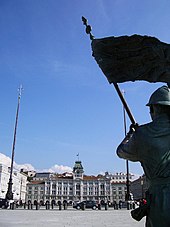
Piazza dell'Unità d'Italia with Monumento della Liberazione.
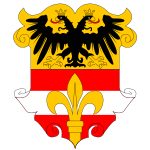
Coat of arms of the imperial city of Trieste 1850-1918 (in front of it a black anchor instead of the gleve)
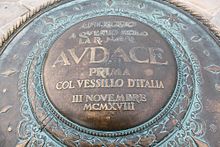
Memorial stone on the Molo Audace, previously Molo San Carlo, to the Italian occupation on November 3, 1918.

General map of Trieste and its surroundings, c. 1888
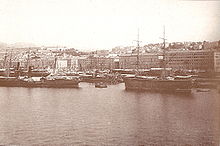
Port in 1893, in the center of the picture Piazza Giuseppina (today Piazza Venezia)

Trieste in 1885
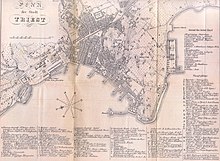
Plan of the city of Trieste around 1857 (Lloyd's travel guide)
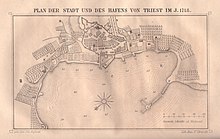
Plan of the city and port of Trieste in 1718 (drawn around 1857 by Joh. Righetti)
Population
Demographic development
Trieste developed in the Roman Empire from a small, relatively insignificant place to a rich, bustling port city. In the 1st century AD, the population of Trieste is estimated at around 12,000 inhabitants. With the disintegration of the Roman Empire, numerous barbarian invasions and the repeated destruction of the city, the population dropped to about 4000 inhabitants in the Middle Ages.
Only with the appointment as a free port in 1719 and the associated increasing importance within the Austrian monarchy, the city experienced a renewed upswing, which resulted in particular in a rapid population growth: if around 1717 only 5600 people lived in Trieste, in 1800 there were already 20,900. In 1900 Trieste, including the military (1953 men), had 134,143 inhabitants - with the 13 suburbs and the eleven villages belonging to the territory of Trieste 178,599 inhabitants - who were mainly of Italian nationality (24,679 Slovenes, 8880 Germans) and of Roman Catholic religion (1792 Protestants, 1378 Greek Orthodox, 4954 Jews).
After 1945 there was a great increase in the population of Trieste, because in Dalmatia and Istria the majority of the Italian population, whether voluntarily or forced, left communist Yugoslavia for the north. This led to a great housing shortage in Trieste and the construction of shanty camps. Since the mid-1960s, the population has been decreasing again. The significant population decline of 25% is due to suburbanization, to the onward migration of the many Italian-speaking post-war refugees from Dalmatia or Istria, but also to the economic isolation from which Trieste suffered for a long time. However, with the EU accession of Slovenia in 2004 and Croatia in 2013, this border location has become an advantage for Trieste. According to the 2011 ISTAT census, in contrast to Trieste's "youthful" urban image, the average age of Trieste's residents is 48.9 years (Italy: 43.3 years) due to the many out-of-town students, and a further significant increase is expected. In surveys of the average income of the population, Trieste regularly ranks as the leading city in northeastern Italy, ahead of Bolzano, Padua, Vicenza and Venice.
The following overview shows the population figures according to the respective territorial status between the years 1617 and 2009. Until 1857, these are mostly estimates, from 1869 onwards census results from Statistik Austria and from 1921 onwards from ISTAT.
| Number of inhabitants | ||||||||||||||||||||||||||||||||||||||||||||||||||||||||||||||||||||||||||
|
|
| ||||||||||||||||||||||||||||||||||||||||||||||||||||||||||||||||||||||||
Ethnic groups
Trieste, due to its geographical position and past, unites different peoples, languages and religions.
Already since the 18th century Trieste was inhabited by different ethnic groups, which brought with them their cultures and religions as well as their own traditions. At the end of the 19th century, Italians formed the majority of Trieste's population (62%), followed by Slovenes (14%) and German Austrians (10%). The remaining population was composed of Greeks, English, Armenians and Turks. From 1867 to 1918, Triesteans of all mother tongues had uniform Austrian citizenship.
Today, Italians still form the majority of the population and give the cityscape a predominantly Italian character, although this is still influenced by a larger minority of Slovenians and Croats and a small proportion of Austrians and Greeks. For some years now, other nationalities such as Albanians, Chinese and Africans have also been represented in Trieste and increasingly characterize individual neighborhoods.
In addition to the Roman Catholic majority with its many churches, there is a Greek Orthodox community with the church of San Nicolo dei Greci, a Serbian Orthodox community with the church of San Spiridione, an Italian Evangelical community with its Protestant church, the Waldensian community with the church of San Silvestro, and an Armenian community with the church of Madonna delle Grazie. The Muslim community in Trieste includes about 6,000 members from more than 30 different countries.
The Jewish community of Trieste today counts about 600 members. The Jewish families come from Central Europe, but also from Corfu and the rest of the Mediterranean. The two synagogues, where people prayed according to different rites, were merged 20 years ago. According to Andrea Mariani, president of the Jewish community, today services are held Askenazic with Sephardic customs, resulting in a distinct Triestine rite. 6,000 members the community had before World War II, one of the largest in Italy by population percentage, 2.5 percent in 1938. Besides the synagogue, points of Jewish intellectual life and memory are the Jewish Museum "Carlo e Vera Wagner", the ghetto in the Citta Vecchia, Via San Nicolo 30 with the antiquarian bookshop "Umberto Saba", the Jewish Cemetery and the Risiera di San Sabba.
Languages
The urban population speaks mainly Italian or Triestinian, while Slovenian is spoken in some suburbs and in the surrounding countryside. A very small minority still speaks German. For a long time the Italian language was not properly developed in Trieste and its surroundings. Until the beginning of the 19th century, the Friulian variety Tergestino was spoken. The Tergestino disappeared when the importance of other languages and dialects such as Venetian, Slovenian and German increased.
A new Italian dialect developed, called Triestine (Italian Triestino, vernacular Triestín). This dialect resembles Venetian, but also contains elements of the Friulian, Slovenian, Croatian, German and Greek languages. The Italian writer Claudio Magris calls the dialect almost a language of its own.
Unlike many other dialects, the Triestine dialect has not declined in recent years, but is now actively spoken by the entire Triestine population and especially in official communications. Closely related to the Triestine dialect is the life motto of the Triestine people "Sempre allegri, mai passion, viva là e po bon!" ("Always cheerful, never suffer, live here and forget the rest").
Economy and transport
Trieste is an Italian port city with good connections to Central Europe. Due to years of isolation at the Iron Curtain, traditional trade routes were interrupted and the economy stagnated, while the city established itself as an international research center and university city. Trieste has been the starting point of the Transalpine Oil Pipeline since 1964. Since the late 1990s and the accession of Slovenia and Croatia to the EU, the city has been undergoing an economic awakening. Important companies such as Assicurazioni Generali, Fincantieri or Illy have their headquarters in Trieste today.
In line with the economic development after 1945, the real estate market in Trieste was underdeveloped for a long time and is still at a low level compared to other Italian cities, although there have been positive impulses in recent years. This is due, on the one hand, to the Silk Road initiative, the emerging urban tourism, the very good quality of life and, on the other hand, to the very low price level so far. Properties in the historic center near the sea, especially in Barcola with its bathing and leisure facilities, and on the surrounding coast are particularly sought after. The relevant land register law originates from the old Austrian legislation and has been adopted by the Italian legal system after 1918 in Trieste, as well as in the provinces of Trento, Bolzano and Gorizia, and in some municipalities of the provinces of Udine, Brescia, Belluno and Vicenza.
Shipping
The Port of Trieste is one of the largest Italian ports, important seaport of the upper Adriatic and, along with Gioia Tauro, the only deep-water port in the central Mediterranean for seventh generation ships. Trieste has also established itself as the most important port for oil tankers in the Mediterranean. There are seven post-Panamax cranes at a quay length of 770 meters. At the Trieste Marine Terminal, modern container ships can be unloaded at a natural water depth of 18 meters. The container terminal in the port has a capacity of 11,500 trains a year and consists of five tracks, each 600 meters long, and three rail-guided cranes.
Freeport
The Port of Trieste has a free trade zone or is a free port and has five free zones secured by the International Peace Treaty of 1947. The free zones of Trieste, a unique feature of the Italian and European legal system, offer various advantages to transit goods that are stored or processed, since they are located in a customs territory of the European Union. The exemption from customs clearance entails a number of favorable conditions. Thus, goods arriving from non-EU countries can be unloaded and stored without customs duties, VAT and other import fees until these goods cross the borders of the EU. All types of goods can be stored indefinitely, the origin of the goods can be maintained, and the free port can host any type of industry, trade or auxiliary activity.
Due to its geographical location, it is an important trading port for Germany, Austria, Luxembourg, Hungary, the Czech Republic, Slovakia and Italy with connections to the Far East, direct connections in the Mediterranean, shipping companies specializing in shipping areas in the Middle East, India, Pakistan and East Africa as well as fast direct connections to the hubs on the Mediterranean with connections to numerous other worldwide destinations. Important trade routes run via Trieste to Turkey or Greece and from there via Iran or the Suez Canal to China.
In addition, there have recently been extensive Chinese initiatives for the further and intensive expansion of the Silk Road with its economic corridors and transport lines on the one hand from the Shanghai deep-water port of Yangshan via the Suez Canal, the Greek port of Piraeus to the deep-water port of Trieste, and on the other hand as an overland route starting in the Chinese coastal city of Yiwu via Kyrgyzstan and Iran to Turkey. Particularly with regard to Turkey and the land connections to East Asia, trailers are used in RoRo traffic. Trieste is the largest railroad port in Italy, in addition to the access to the Silk Road, with a total of 7631 trains handled in 2016 and 8681 trains handled in 2017. Since 2017, Trieste has had freight train connections with the Port of Duisburg, which is linked to China via the so-called "New Silk Road". Through this cooperation with the Port of Duisburg (- which is traditionally connected to the North Sea ports such as Rotterdam and Antwerp), the Port of Trieste and thus the "maritime Silk Road" (- connecting Trieste via the Mediterranean Sea, the Suez Canal, the Gulf of Aden, Nairobi in Ethiopia, Kolkata in India, Colombo in Sri Lanka, via Jakarta to the Far East) is connected to the land connection "New Silk Road" (- connecting Western Europe via Moscow and Kazan to China). There are close direct relations between the city of Trieste and the Chinese port city of Shenzhen. Within the framework of the new Chinese Silk Road initiative, it is also a question of special logistics support between the North Adriatic port and Shanghai or Guangdong, with the involvement of the China Communications Construction Company.
With regard to the port, the customs facilities in the Freeport, and the possibilities offered by international law through the treaties signed in the post-World War II period (including United Nations Security Council Resolution 16 of January 10, 1947, the Treaty of Osimo), comparisons are also repeatedly made between Trieste and Singapore.
In 2016, cargo handling at the port amounted to a volume of 59 million tons, including 43 million tons of liquid cargo such as crude oil, which is forwarded via the SIOT terminal (via the Transalpine Oil Pipeline in the direction of Austria (Schwechat) and Germany (Ingolstadt), with a branch as far as the Czech Republic). This supplies eight refineries in Austria, southern Germany and the Czech Republic. Austria receives 90 percent of its crude oil via TAL, Bavaria and Baden-Württemberg 100 percent (Germany 40 percent) and the Czech Republic 40 percent. The remaining cargo volume at the port consists of solid bulk (2 million tons) such as coal, wood, minerals, grain and oilseeds, among others. Container throughput is not as significant at 486,507 TEUs (2016) and 616,156 TEUs (2017).
In addition to its function as a transhipment point for crude oil and other goods, the Port of Trieste also serves as a ferry and cruise port.
Fishing boats anchor at the Molo Veneziano near Piazza Venezia. Fishing is done with "lampare" (large lamps) in summer and with "redi di posta" (smaller fishing nets) in autumn and winter. In the Gulf of Trieste, because of the crystal clear nutrient-poor water with the few plankton, fishing is challenging in itself. The fishing season lasts mainly from May to July. With regard to fish reproduction, fishing is prohibited in August and restricted in winter. In 2009, there were less than 200 professional fishermen in the city.
Port history
The importance of the port of Trieste as a seaport and transhipment center grew from the 18th century with the elevation of the city to a free port by Emperor Charles VI in 1719. The opening of the Suez Canal in 1869 strengthened Trieste's position as a trade and economic center. This was because the most convenient and shortest sea route from the Middle and Far East to Europe was via the Suez Canal through the Mediterranean Sea, up the Adriatic Sea to Trieste. The port of Trieste thus became a gateway to Europe and gave the Central European economic area direct access to distant countries in Asia, not least due to new railroad connections to Trieste towards the end of the 19th century.
In 1914, twelve shipping companies with a total of 716,198 gross registered tons (GRT) had their headquarters in Trieste. The largest of these were:
- Austrian Lloyd with 65 ships and a total of 237,000 GRT
- Austro-Americana with 34 ships and 145,000 GRT
- Tripcovich & Co with 16 ships and 58,000 GRT
- Navigazione Libera Triestina (NLT) with 16 ships and 42,000 GRT
In recent years, the port of Trieste has received increased competition from the nearby port of Koper in Slovenia and from the port of Rijeka in Croatia (the deepest access for ships in the Adriatic). The Port of Trieste is divided into five free zones, three of which are privately operated. It has twelve quays and 47 operational berths.
Rail transport
From today's Trieste Centrale station (originally Trieste South station), which is located on the site of the first South station, there are heavily used rail connections in the direction of Venice/Mestre or Milan and Udine. Trieste is part of the planning for the TEN Corridor V, is to be connected to the Italian TAV network and negotiations are underway regarding a fast connection or railroad line to Ljubljana.
Historically, the railroad network of the city of Trieste is also based on railroad lines from the old Austrian period. The Südbahn company reached Trieste after bridging the Semmering as early as 1857. In order to break the monopoly position of the private Südbahn, the k.k. Staatsbahnen (kkStB) built a second rail link that had to cross the Tauern, the Karawanken and the Wocheinerpass. This railroad connection is usually referred to as the Wocheinerbahn, Transalpina or New Alpine Railway. The terminal station Trieste San Andrea (originally: Trieste State Station, since 1923 Campo Marzio, located at the far western tip in the harbor and southwest of the South Station) has not been in operation since 1959, but has housed the Trieste Railway Museum since 1984.
Before the First World War, Trieste was connected to international D trains that ran from Berlin (Anhalter Bahnhof) to Trieste in what was then Austria-Hungary. From 1912, the Simplon Express reached Trieste, creating a direct connection to Paris and London. The trains connected with the ships of the Austrian Lloyd from Trieste to Alexandria in Egypt. After World War I, the Simplon Express was extended beyond Trieste to Istanbul, becoming the Simplon Orient Express. This train became one of the few connections from Western Europe to Eastern Europe after World War II, but traffic was so low that in 1950 just three cars crossed the Yugoslavian border between Trieste and Sežana.
Until about 1975, ÖBB still operated a direct connection from Vienna via Graz, Maribor and Ljubljana to Trieste with the Miramare railcar express train. The diesel railcar Blauer Blitz was used for the train. Currently, in contrast to the Cold War period and the 1990s, there is no fast direct travel service from Trieste towards Ljubljana, Graz or Budapest and Vienna. In the fall of 2013, one travel service from Vienna required changing trains in Udine, while two others involve multiple changes via Salzburg and the Tauernbahn. Since 2018, there is again a daily morning and evening direct connection between Trieste and Ljubljana with modern railcars (2nd class only). The journey time is currently (2019) just over 2 hours 30 minutes. Interrail tickets are valid on the route.
The connection with the Trieste hinterland in Istria was made, among other things, by the narrow-gauge railroad Trieste-Parenzo (now Poreč), also called "Parenzana". This railroad line has been closed since 1935, the route is used (promoted by the European Union) as an international cycling trail ("Path of Health and Friendship").
Local traffic
The standard-gauge Trieste tramway existed from 1876 to 1970. Only the meter-gauge Trieste-Opicina railroad line still exists as a means of local rail transport. Originally, the steep section was operated by rack-and-pinion locomotives; in 1928, the service was replaced by a rail cableway. The mountain railroad to Opicina, one of the last lines in the world to use adhesion-driven vehicles to handle a steep section of track using the cable pull principle, underwent general rehabilitation between October 2012 and August 2014, during which time rail replacement services were in place. The long rehabilitation period, unresolved costs and protests from locals and tourists about the unprofessional approach of the city administration and the public operator led to heated discussions.
Trieste Trasporti S.p.A. is the concessionaire of local public transport in the province of Trieste. The company is owned 60 percent by the public sector and 40 percent by the private Arriva.
→ Main article: Trieste Trasporti
Air traffic
Trieste International Airport (TRS) is located 33 kilometers northwest of Trieste at the commune of Ronchi dei Legionari.
As the largest airport in Friuli-Venezia Giulia, the airport plays a strategically important role for the entire region. Due to its geographical location, in addition to the Friuli-Venezia Giulia region with its 1.2 million inhabitants, parts of the Veneto region and Carinthia, as well as areas in Slovenia and Croatia, are within the airport's catchment area, which thus covers a total of approximately five million inhabitants. Among others, there are flight connections to Rome (Alitalia), Milan MXP (Air Alps) and many more.
Tourism
In 2014, 332,000 tourists visited Trieste (including 185,000 Italians, 32,000 Austrians, 19,000 Germans, 8,000 Britons, 7,000 U.S. citizens), an increase of 25.24% since 2010.
Resident companies
The following companies and groups have their headquarters in Trieste:
- Assicurazioni Generali, insurance group and Fortune Global 500 company
- Allianz Spa, insurance group and Fortune Global 500 company
- Fincantieri, shipbuilding company
- Illy, coffee production
- Italia Marittima (until 2006 Lloyd Triestino), shipping company
- Stock, spirits producer with factory, with the commercial headquarters located in Milan since 2009.
- Telit, Italian cell phone manufacturer
Other prominent companies such as Wärtsilä (with the former factory of Grandi Motori Trieste), AcegasApsAmga (Hera Group), Autamarocchi SpA, Banca Generali SpA, Genertel, HERA Trading, Nuovo Arsenale Cartubi Srl, Jindal Steel and Power Italia SpA, Pacorini SpA, Siderurgica Triestina (Arvedi Group) and the TBS Group produce or have their branch in Trieste.
Trieste is home to many young start-up companies according to the linking of research and development with the help of the local business incubators. Cooperations in connection with the University of Trieste and the Area Science Park exist for this purpose, for example, with Microsoft Corporation, Assicurazioni Generali, Fincantieri and Illy.
In Trieste there are more than 50 companies involved in trade, processing and technology but also training and research regarding coffee, and many of these companies are united in the "Trieste Coffee Cluster". Also, the Illy Università del caffè, founded in Naples in 1999, was moved to Trieste in 2002. Trieste is considered Italy's capital in terms of coffee, especially because it also handles a large part of Italy's coffee imports (about 2-2½ million bags).
Furthermore, in Trieste there are several young companies involved in design. Since 2002, the young fashion designers competition ITS (International Talent Support) is held in July.

The port of Porto Vecchio
.jpg)
Traffic development, 1912

Merchants and passengers at the Molo San Carlo, around 1900
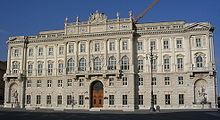
Seat of the Lloyd Triestino, until 1918 Austrian Lloyd
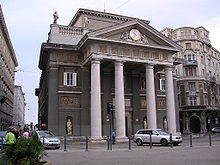
The Trieste Stock Exchange (2004)

Assicurazioni Generali, facade detail at Casa Stratti
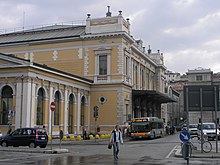
The train station of Trieste
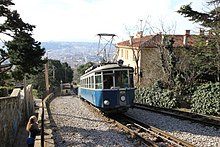
Railroad line Trieste-Opicina
Politics and administration
Mayor
See also: List of mayors of the city of Trieste
The following mayors have presided over the city since 1949.
| Term | Mayor | Party |
| 1949–1957 | Gianni Bartoli | Democrazia Cristiana |
| 1958–1966 | Mario Franzil | Democrazia Cristiana |
| 1967–1977 | Marcello Spaccini | Democrazia Cristiana |
| 1978–1983 | Manlio Cecovini | Partito Liberale Italiano |
| 1983 | Deo Rossi | Democrazia Cristiana |
| 1983–1986 | Franco Richetti | Democrazia Cristiana |
| 1986 | Arduino Agnelli | Partito Socialista Italiano |
| 1986–1988 | Giulio Staffieri | Lista per Trieste |
| 1988–1992 | Franco Richetti | Democrazia Cristiana |
| 1992–1993 | Giulio Staffieri | Lista per Trieste |
| 1993–2001 | Riccardo Illy | - – |
| 2001–2011 | Roberto Dipiazza | Forza Italia |
| 2011–2016 | Roberto Cosolini | Partito Democratico |
| since 2016 | Roberto Dipiazza | Dipiazza per Trieste |
City breakdown
See also: List of districts and neighborhoods of Trieste
Since 1976, the municipality of Trieste has been divided into seven administrative districts (circoscrizioni), each of which includes several districts (rioni) or villages (frazioni):
| Administrative district | Districts and localities |
| 1. altopiano ovest | Santa Croce (Križ), Prosecco (Prosek), Contovello (Kontovel) |
| 2. altopiano est | Villa Opicina (Opčine), Banne (Bani), Trebiciano (Trebče), Padriciano (Padriče), Gropada, Basovizza (Bazovica) |
| 3rd Roiano - Gretta - Barcola - Cologna - Scorcola | Miramare (Miramar), Grignano (Grljan), Barcola (Barkovlje), Gretta (Greta), Roiano (Rojan), Scorcola, Cologna, Guardiella (Vrdela)¹ |
| 4. Città Nuova - Barriera Nuova - San Vito - Città Vecchia | Città Nuova (Borgo Teresiano), Città Vecchia, Barriera Nuova, Borgo Giuseppino, San Vito |
| 5. barriera Vecchia - San Giacomo | Barriera Vecchia (Stara mitnica), San Giacomo (Sv. Jacob), Chiarbola (Čarbola)¹, Santa Maria Maddalena Superiore¹ |
| 6. san Giovanni - Chiadino - Rozzol | Rozzol, Chiadino (Kjadin), Guardiella (Vrdela)¹, Longera (Lonjer) |
| 7 Servola - Chiarbola - Valmaura - Borgo San Sergio | Santa Maria Maddalena Superiore¹, Santa Maria Maddalena Inferiore, Chiarbola (Čarbola)¹, Servola (Škedenj) |
¹ only a part belongs to the administrative district
Coat of arms
The coat of arms of the city of Trieste shows a white hooked spear or gleve (as a heraldic form of the lily), popularly known incorrectly as a "halberd". According to legend, the weapon was in the possession of St. Sergius, an alleged Roman officer and martyr. The spear, which should be of ancient origin, but dates from the Middle Ages, is exhibited in the Cathedral of San Giusto.
Town twinning
- Lebanon
 Beirut, Lebanon (since 1956)
Beirut, Lebanon (since 1956) - Cameroon
 Douala, Cameroon (since 1971)
Douala, Cameroon (since 1971) - Austria
 Graz, Austria (since 1973)
Graz, Austria (since 1973) - Brazil
 Santos, Brazil (since 1977)
Santos, Brazil (since 1977) - United Kingdom
 Southampton, United Kingdom (since 2002)
Southampton, United Kingdom (since 2002) - France
 Le Havre, France
Le Havre, France
There has been a cooperation agreement with Venice since January 10, 2008, and with the Slovenian capital Ljubljana since February 18, 2008.

Government Palace in the Italian Unity Square, Trieste
Sports
Trieste is home to the soccer club US Triestina, which currently plays in Serie C. The Stadio Giuseppe Grezar, the former home of US Triestina, also hosted the 1934 World Cup Round of 16 match between Czechoslovakia and Romania (2-1).
Personalities
Famous personalities of the city are listed in the list of personalities of the city of Trieste.
Places or streets named after Trieste
There is a Trieste Park in Berlin-Dahlem.
There is a Triester Street in Munich-Ramersdorf-Perlach.
There is a Triester Street in Nuremberg-Schweinau.
In Vienna, Triester Straße is the best-known arterial road in the direction of the south or Süd Autobahn; it runs, starting from the Südbahn, through the 10th district, Favoriten, and the 23rd district, Liesing, to the southern city limits and continues southward as the former Bundesstraße 17. Triester Straße existed as early as 1879 as an imperial road from Vienna in the direction of Trieste.
In Graz, Triester Straße is one of the most important arterial roads and also the second longest street in the city. Graz Triester Straße starts at Karlauer Platz in Graz-Gries and ends in Graz-Puntigam at the southern city boundary with house number 509, where it passes over to Feldkirchen bei Graz. There it leads with the house numbers from 1 to 395 in north-south direction through the entire municipal area.
In Ljubljana, the capital of Slovenia, Tržaška cesta (Trieste Street) runs from the square called Trg Mladinskih delovnih brigad in a southeasterly direction parallel to the former Austrian Southern Railway to the village of Brezovica pri Ljubljani.
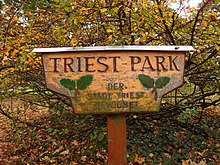
Trieste Park in Berlin
Search within the encyclopedia